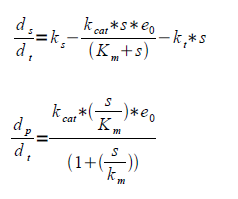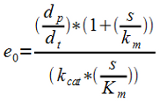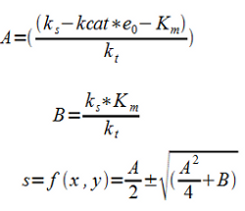Team:Uppsala-Sweden/Modelling
From 2009.igem.org
(Difference between revisions)
Karl.brune (Talk | contribs) (→Modelling of ethanol production) |
Karl.brune (Talk | contribs) (→Modelling of Advanced Ethanol Production) |
||
| Line 12: | Line 12: | ||
# Assuming quasi steady state (Michaelis Menten Kinetics) | # Assuming quasi steady state (Michaelis Menten Kinetics) | ||
| - | + | [[Image:ek_0.png]] | |
| - | + | [[Image:ek_1_2.png]] | |
Having the Km and Kcat values gives e0 from level of product formation. | Having the Km and Kcat values gives e0 from level of product formation. | ||
| - | + | [[Image:ek_3.png]] | |
# Having e0 and letting kt go towards zero, (kt here represents the rate at which our substrate pyruvate "disappears" into the Krebbs cycle), gives ks | # Having e0 and letting kt go towards zero, (kt here represents the rate at which our substrate pyruvate "disappears" into the Krebbs cycle), gives ks | ||
| - | + | [[Image:ek_4.png]] | |
# Assuming Ks to be constant within the interval and assuming steady-state | # Assuming Ks to be constant within the interval and assuming steady-state | ||
| - | + | [[Image:ek_5.png]] | |
S is a function of f(x,y) where x is proportional to e0 and y is proportional to kt | S is a function of f(x,y) where x is proportional to e0 and y is proportional to kt | ||
| - | + | [[Image:ek_6.png]] | |
Measure for different x and y and fit the function | Measure for different x and y and fit the function | ||
| - | + | [[Image:ek_7.png]] | |
{{Uppsala-Sweden_Footer}} | {{Uppsala-Sweden_Footer}} | ||
Revision as of 18:20, 20 October 2009

Modelling of Advanced Ethanol Production
For our modell we have some basic assumptions that are
- Co-evolution of the of the ethanol producing pathway,
making km and kcat being highly similar for pdc as well as ADH
- Assuming quasi steady state (Michaelis Menten Kinetics)
Having the Km and Kcat values gives e0 from level of product formation.
- Having e0 and letting kt go towards zero, (kt here represents the rate at which our substrate pyruvate "disappears" into the Krebbs cycle), gives ks
- Assuming Ks to be constant within the interval and assuming steady-state
S is a function of f(x,y) where x is proportional to e0 and y is proportional to kt
Measure for different x and y and fit the function
 "
"









